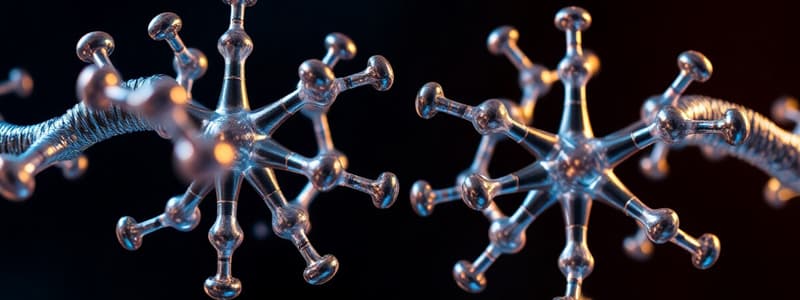Podcast
Questions and Answers
What designates the Z geometry of tamoxifen?
What designates the Z geometry of tamoxifen?
- It allows tight binding to estrogen receptors. (correct)
- It prevents inhibition of signalling.
- It weakens drug efficacy.
- It enhances cell growth.
What does the 'E' designation in alkene geometry indicate?
What does the 'E' designation in alkene geometry indicate?
- Non-polar bonds.
- Cyclic structures.
- Priority groups on the same face.
- Priority groups on opposite faces. (correct)
What is an example of a racemic mixture?
What is an example of a racemic mixture?
- A mixture of one enantiomer only.
- A 1:1 mixture of two non-superimposable mirror images. (correct)
- A mixture of diastereoisomers.
- A chiral compound with no optical activity.
Why is stereoisomerism important in the pharmaceutical industry?
Why is stereoisomerism important in the pharmaceutical industry?
What is a characteristic of stereoisomers?
What is a characteristic of stereoisomers?
Which term is NOT considered synonymous with chirality?
Which term is NOT considered synonymous with chirality?
What is the effect of the correct geometry on pharmaceuticals?
What is the effect of the correct geometry on pharmaceuticals?
What is true about constitutional isomers?
What is true about constitutional isomers?
Which of the following statements regarding geometric isomers is correct?
Which of the following statements regarding geometric isomers is correct?
What does the prefix Z represent in IUPAC nomenclature?
What does the prefix Z represent in IUPAC nomenclature?
What can be inferred about fumaric acid based on its geometry?
What can be inferred about fumaric acid based on its geometry?
What is a characteristic of constitutional isomers?
What is a characteristic of constitutional isomers?
What is the first step when determining the configuration of a chiral carbon?
What is the first step when determining the configuration of a chiral carbon?
How are atoms attached to the chiral carbon prioritized?
How are atoms attached to the chiral carbon prioritized?
If two atoms attached to the chiral carbon are the same, what should be done next?
If two atoms attached to the chiral carbon are the same, what should be done next?
Which configuration does the order 1→ 2→ 3 clockwise indicate?
Which configuration does the order 1→ 2→ 3 clockwise indicate?
In determining the configuration of acebutolol, which atom has the highest priority?
In determining the configuration of acebutolol, which atom has the highest priority?
What action should be taken if the priority 4 atom is not at the back?
What action should be taken if the priority 4 atom is not at the back?
When analyzing acebutolol, what determines the direction of priority order?
When analyzing acebutolol, what determines the direction of priority order?
If the order of atoms around the chiral carbon is 1→ 2→ 3 anticlockwise, what configuration is present?
If the order of atoms around the chiral carbon is 1→ 2→ 3 anticlockwise, what configuration is present?
During the analysis of acebutolol, what distinguishes the two CH2 groups attached to the chiral carbon?
During the analysis of acebutolol, what distinguishes the two CH2 groups attached to the chiral carbon?
What is a requirement for a carbon atom to be classified as chiral?
What is a requirement for a carbon atom to be classified as chiral?
Which statement correctly describes the nature of enantiomers?
Which statement correctly describes the nature of enantiomers?
According to the Cahn-Ingold-Prelog rules, what does a clockwise arrangement of groups around a chiral carbon indicate?
According to the Cahn-Ingold-Prelog rules, what does a clockwise arrangement of groups around a chiral carbon indicate?
How can you determine if a compound is achiral?
How can you determine if a compound is achiral?
What type of carbon is found in the structures of most chiral compounds?
What type of carbon is found in the structures of most chiral compounds?
Which of the following pairs of compounds can be classified as enantiomers?
Which of the following pairs of compounds can be classified as enantiomers?
What does a designation of 'S' signify in chiral compounds?
What does a designation of 'S' signify in chiral compounds?
What is the primary characteristic of chiral molecules?
What is the primary characteristic of chiral molecules?
Which of the following is NOT a characteristic of enantiomers?
Which of the following is NOT a characteristic of enantiomers?
Flashcards
Constitutional Isomers
Constitutional Isomers
Molecules with the same molecular formula but different arrangements of atoms in the molecule. Atoms are connected in a different order.
Geometric Isomers
Geometric Isomers
Molecules with the same formula but different arrangement in space.
Enantiomers
Enantiomers
Molecules with the same chemical formula but different arrangements in space that are mirror images of each other and cannot be superimposed.
Diastereomers
Diastereomers
Signup and view all the flashcards
Stereocenter
Stereocenter
Signup and view all the flashcards
Alkene Geometry
Alkene Geometry
Signup and view all the flashcards
Z and E Nomenclature
Z and E Nomenclature
Signup and view all the flashcards
Stereochemistry
Stereochemistry
Signup and view all the flashcards
Stereocenter (Chiral Carbon)
Stereocenter (Chiral Carbon)
Signup and view all the flashcards
Racemic Mixture
Racemic Mixture
Signup and view all the flashcards
Chiral Carbon
Chiral Carbon
Signup and view all the flashcards
Chiral Molecule
Chiral Molecule
Signup and view all the flashcards
Chirality
Chirality
Signup and view all the flashcards
Achiral
Achiral
Signup and view all the flashcards
Achiral Molecule
Achiral Molecule
Signup and view all the flashcards
Cahn-Ingold-Prelog (CIP) Rules
Cahn-Ingold-Prelog (CIP) Rules
Signup and view all the flashcards
R/S Notation
R/S Notation
Signup and view all the flashcards
Stereochemical Assignment
Stereochemical Assignment
Signup and view all the flashcards
Atom Prioritization
Atom Prioritization
Signup and view all the flashcards
Priority 4 Placement
Priority 4 Placement
Signup and view all the flashcards
R/S configuration
R/S configuration
Signup and view all the flashcards
Acebutolol Stereochemistry
Acebutolol Stereochemistry
Signup and view all the flashcards
Priority 4 at Front
Priority 4 at Front
Signup and view all the flashcards
Inactive Enantiomer
Inactive Enantiomer
Signup and view all the flashcards
Stereoisomers
Stereoisomers
Signup and view all the flashcards
Study Notes
Chirality (Abridged)
- This presentation provides an overview of chirality, a key concept in understanding the structure and function of pharmaceutical molecules.
- It covers constitutional isomerism, geometric isomerism (cis and trans), IUPAC nomenclature (Z and E), stereoisomerism, and an introduction to chiral carbons.
- The information is presented in an abridged format, providing a condensed summary of the topic.
- It emphasizes the importance of chirality in determining the function and efficacy of drugs.
Constitutional Isomerism
- Constitutional isomers, also called structural isomers, are molecules with the same chemical formula but different connectivity of carbon atoms.
- They have different physical and chemical properties, including melting point, boiling point, solubility, and density.
- Different connectivity leads to varying functional groups within the molecules.
- Constitutional isomers cannot interconvert.
Example of C9H8O4 Isomers
- Aspirin (plant/synthetic origin), a non-steroidal anti-inflammatory drug (NSAID), has analgesic, antipyretic, and antiplatelet properties.
- Caffeic acid, a plant-derived compound, is a key intermediate in lignin biosynthesis with anti-cancer and antioxidant properties.
- 4-Hydroxyphenyl-pyruvic acid is found in animals and is an intermediate in the metabolism of tyrosine. If not processed efficiently excess can become toxic.
Geometric Isomerism (Cis and Trans)
- Geometric isomers have the same chemical formula and connectivity, but differ in the spatial arrangement of their substituents around a double bond (alkene).
- Two geometric isomers are cis and trans isomers. Cis isomers have substituents on the same side of the double bond; trans isomers have substituents on opposite sides of the double bond.
- Isomers are not interconvertible between cis and trans forms at ambient or body temperatures.
Examples of C4H4O4 Isomers (Maleic and Fumaric Acid)
- Maleic acid (cis-form) is commonly used as a salt base for medicines in the pharmaceutical industry. Its melting point is 139-140°C.
- Fumaric acid (trans-form) is also used as a salt base for medicines in the pharmaceutical industry. Its melting point is 287°C.
IUPAC Nomenclature for Alkenes (Cahn-Ingold-Prelog, CIP Rules)
- The CIP rules provide a systematic way to name alkenes.
- The prefix 'Z' is used when the two highest priority groups are on the same side of the double bond.
- The prefix 'E' is used when the two highest priority groups are on opposite sides of the double bond.
Worked Example: Fumaric Acid
- Fumaric acid is an alkene with the molecular formula C4H4O4.
- When using the CIP rules, the groups on both sides of the double bond, that have the highest priority dictate whether a molecule is Z or E.
- The groups are on opposite sides so it's an E isomer.
Why is Geometry Important?:
- The correct Z (trans) geometry of tamoxifen is crucial for tight binding to the estrogen receptor.
- This leads to inhibition of cell signals, which prevents breast cancer cell growth.
Stereoisomerism
- Stereoisomers are molecules with the same atomic connectivity, but different spatial arrangements.
- Stereoisomers are categorized as either enantiomers or diastereomers.
- Enantiomers are non-superimposable mirror images, while diastereomers are non-superimposable non-mirror images.
- Stereoisomerism is important for the pharmaceutical industry. Incorrect stereochemistry can lead adverse effects in patients.
Terminology
- Stereoisomerism is synonymous with chirality.
- A chiral carbon atom has four different atoms or groups attached.
- A racemic mixture (racemate) is a 1:1 mixture of enantiomers.
- Optically inactive implies achirality.
- Enantiomers are non-superimposable mirror images, while diastereomers are non-superimposable non-mirror images.
What is a Chiral Carbon?
- A chiral carbon atom is sp³ hybridised and has four different atoms or groups attached to it.
- Chirality can be determined by whether the molecule is superimposable on its mirror image.
- Non-superimposable mirror images are called enantiomers.
Practice: Identify the Chiral Carbons
- A series of chemical structures and examples of chiral molecules are presented. Students are encouraged to identify chiral carbons within the molecules.
Nomenclature
- The IUPAC system uses CIP rules, assigning R or S configurations to chiral centers.
- R configuration is assigned when groups have a clockwise order of decreasing priority, and S when there's an anti-clockwise order.
Steps to Classify Chirality
- Steps for determining chiral center configurations (R/S) are detailed.
Worked Example: Acebutolol
- A worked example demonstrates the process of identifying the chiral carbon and determining its R or S configuration in acebutolol.
What do we do if Priority 4 Atom not at Back?
- Addressing cases where the priority 4 atom is not at the back involves rotating the structure.
Key Messages: Alkene Geometry
- Z and E designations are crucial for describing alkene geometry.
- The priority of substituents is essential for accurate nomenclature.
- Alkene geometry is vital for proper binding to target molecules. Correct geometry contributes to better drug potency.
Interactions with Other Enantiomers
- Chiral species (receptors and enzymes) often interact differently with different enantiomers.
- The correct enantiomer is crucial, since incorrectly matched shapes lead to poor binding or no binding at all.
Vigabatrin (Sabril®)
- Vigabatrin is used in epilepsy treatment.
- The (S)-enantiomer is active as an anti-convulsant.
- Increases GABA levels to reduce seizures.
Fluoxetine (Prozac®)
- Fluoxetine is used in depression treatment.
- The (S)-enantiomer is the pharmacologically active form.
- Eliminates rapidly to a lower volume from the bloodstream.
Warfarin
- Warfarin (a blood thinner) is administered as a racemate.
- The (S)-enantiomer is more effective and longer-lasting than the (R) form.
Why are Amines Rarely Chiral?
- Amines can undergo inversion and lose their chirality.
Key Messages
- Pharmaceuticals often have chiral carbons, creating stereoisomerism.
- Enantiomers have opposite rotations of polarized light but the same chemical and physical properties.
Studying That Suits You
Use AI to generate personalized quizzes and flashcards to suit your learning preferences.




